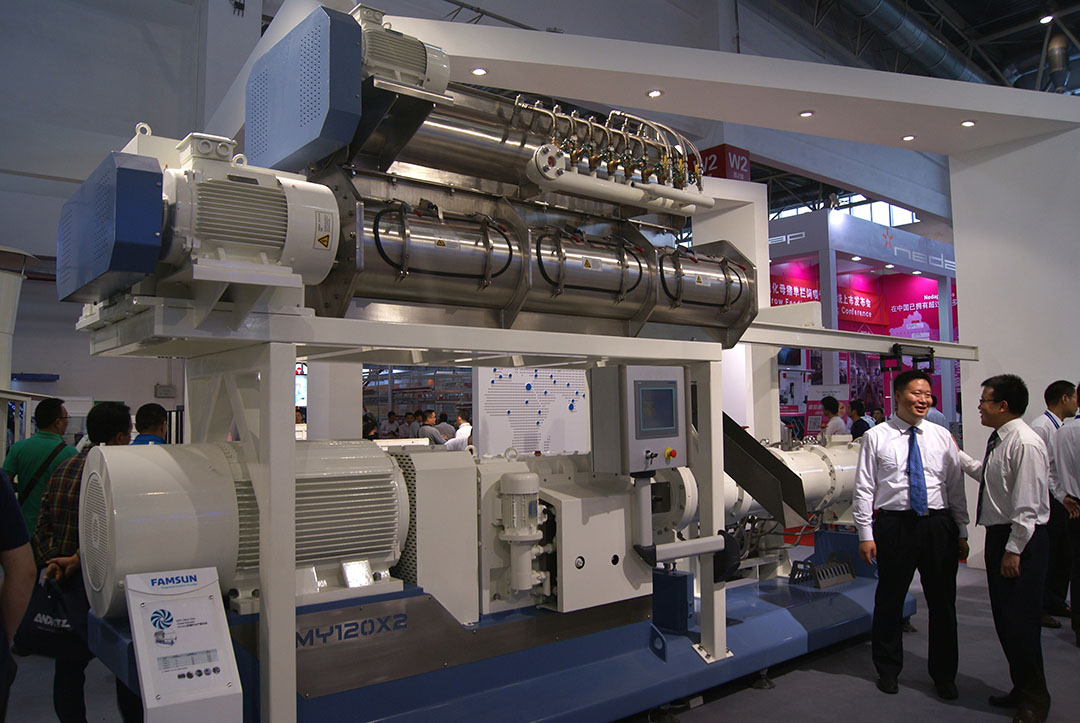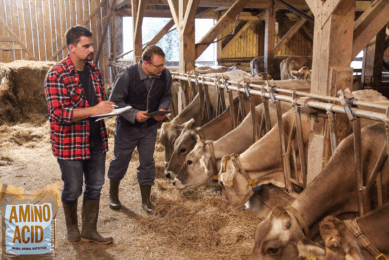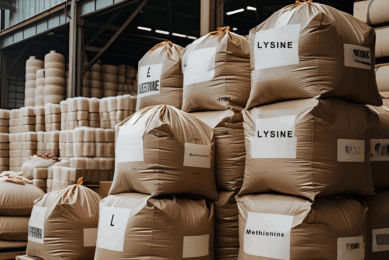Protected proteins for ruminants

Protecting the dietary protein from extensive degradation in the rumen can benefit the animal
Protein that is not degraded in the rumen and reaches the small intestine unmodified, is called rumen bypass protein or rumen undegradable protein (RUP). In the lower gut, the protein is digested by enzymatic hydrolysis. Supplementation of this type of protein can improve productivity in terms of improved efficiency of meat, milk, and wool or hair production. The nutritionist can choose for a RUP with a low solubility rate, which increases the protein supply to the intestines and to greater animal production under practical conditions.
Artificial protection
Various methods have been used for protecting proteins from rumen degradation, such as heat treatment and formaldehyde treatment. These methods are thought to act either by inhibiting proteolytic activity and/or by modifying protein structure in such a way that the number of protease specific bonds that can be cleaved by microbial enzymes is decreased.
Heat treatment of protein is the physical processes to reduce degradability involve the use of dry heating, autoclaving (15 min at 120 – 130°C), and extrusion procedures. These methods can change the structure of proteins (casein, fish meal, soybean meal, groundnut meal, cottonseed meal) in such a way that the proteins became less soluble, thereby lowering concentrations of ammonia in the rumen and improving nitrogen (N) balance. In one study, heat treatment increased milk yield in early lactation from 26.8 to 30.8 litres/day without a change in milk protein content (2.84% and 2.86%, respectively) by the use of heated soybean meal, but no response was noted during the later weeks of lactation.
Heat treatment of soy and ryegrass
Heated soy products were used in two growth trials of about 120 days with cattle of initial weights of 170-190 kg, and improved daily weight gain from 556g to 871g in one trial and from 640g to 844g in another. At the same time, there was an increase in feed intake with the treated soy groups, and feed conversion was improved from 9.8 to 7.3 and from 8.1 to 6.8 in the two trials, respectively.
In a study of the effects of heat treatment using ryegrass, it was shown that oven drying led to a 51% increase in the number of amino acids entering the small intestine compared with fresh ryegrass. Two-thirds of this increase in amino acid flow could be attributed to an increase from 48% to 71% in the proportion of dietary protein escaping rumen fermentation with heat treatment of the forage, with the remainder of the increase attributed to an enhanced synthesis of microbial protein in the rumen.
Excessive heat treatment, however, can reduce the absorption of amino acids in the small intestine, despite an enhanced flow from the rumen compared with control untreated forage. The digestibility of protein within the small intestine was reduced from 72% to 54% with excessive heat treatment and processing.
Formaldehyde treatment
Treatment with formaldehyde is the most widely used process to protect protein. Formaldehyde can form bonds with various reactive groups on protein molecules. These bonds are highly stable in the near neutral pH of the rumen but are readily hydrolysed in the acidic pH of the lower digestive tract.
The amount of formaldehyde applied should not be more than 2g per kg dry matter (DM) or the digestibility in the intestine shall else be decreased. In some experiments on dried grass treated with 3g formaldehyde per 100g CP, a negative response (-5 %) was obtained, in contrast with a positive response (+ 33%) when the same dried grass was treated at an application rate of 1g formaldehyde per 100g CP. The use of formaldehyde at the recommended rate of application decreases the degradability from 70% to about 30%, reduces the ammonia concentration in the rumen and urea concentration in the blood, increases the N flow to the lower gut, and decreases catabolism of essential amino acids in the rumen, thereby increasing the quantities of those amino acids being transported out of the rumen. The improved protein supply together with the reduced load on the liver resulted in the expected improvement of milk production (Table 1) and reproductive efficiency (Table 2). Whether this latter effect is due to improved health of the animal, or whether it is directly due to bypass nutrients remains to be determined.
Other treatments
Treatment of protein sources with fats has been a popular area of research in protecting proteins. In one study, tallow coating of linseed meal (300g of tallow per kg of supplement) increased gains and improved feed efficiency by 15% when used as a steer diet supplement. In another study, unwilted alfalfa silage treated with formic acid and fed to dairy heifers resulted in improved average daily gain when compared to normal unwilted alfalfa silage or hay. Also, Lucerne silage treated with formic acid decreased concentrations of ammonia nitrogen and increased nitrogen and dry matter digestibility when fed to lambs with no effect on food intake or wool production. Other treatments involving tannic acid, wood molasses, and polymerizing agents have been tested mainly in vitro but the first trials with growing animals show that with their use a worthwhile degree of protein protection may be reached.
Points to consider
To apply the concept of protected protein, one should remember that if the protein requirement of an animal is met by feeding a particular protein, then replacing this protein source with protected protein will not result in any improvement in animal performance. Performance cannot be improved if an adequate protein is already being fed. It should also be remembered that the use of physical treatment (heat processing) or chemical treatment (formaldehyde) may not necessarily lead to an improvement in animal performance. Some of the feed ingredients that are so treated may be poorly digested in the small intestine or may have a poor amino acid balance. Therefore, protection of such proteins may be a wasteful process unless followed by an examination of digestibility and amino acid profile. The most practical way of utilising the protein protection concept is the selection of ingredients that have high rumen bypass values.
References are available on request.











